Cultural Tasks for Language Learning and Teaching: The ENACT App
By Müge Satar, Paul Seedhouse, Ahmed Kharrufa, Colin Bone Dodds, Sara Ganassin, Alison Whelan, Newcastle University, UK

Introduction
Many people are motivated to learn foreign languages by their interest in foreign cultures and ways of life, and Newcastle University has developed a free web app to integrate these motivations with a task-based approach (TBLT), so that we can learn languages while carrying out cultural tasks.
The web app we developed as part of an EU-funded project titled Communities, Languages, and Activities App (ENACT) aims to make language learning motivating by tapping into people’s interest in both other cultures and technology – people can learn aspects of a language online while learning how to physically carry or act out an interesting hands-on cultural task such as origami, a traditional dance, or making a Chinese lantern. We have a bank of cultural tasks in a range of languages which are ready to use for language teachers and learners. Learners and teachers can also upload their own favourite cultural activity in their own language so that others can try it out!
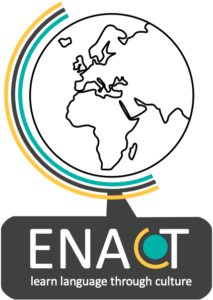
The design of the web app is underpinned by Task-Based Language Teaching (TBLT) criteria (Ellis, 2003) with pre-, during-, and post-task stages which enable learners to focus on linguistic form while engaging in meaningful interaction with the digital materials. The app can also be used for collaborative task completion as learners work together to enact, share, appropriate, and re-enact cultural artefacts and activities from various cultures. Theoretically, the digital artefacts act as catalysts for intercultural exchange and “artifacts and humans together create particular morphologies of action” (Thorne, 2016, p. 189). Technically, the web app is built on the H5P engine with a streamlined and structured package composed of several H5P content types, such as interactive video, hotspots, and drag and drop (Dodds et al., 2021).
This article explains how and why the ENACT app was designed and built, what it can do, and how learners and teachers can use it for learning and teaching languages and cultural practices for any community and language. For teachers, we show how you can adapt it to your own professional practice. Video tutorials on the accompanying website give users a hands-on introduction to using the app and making the most of all of its features.
How does the app work?
How can teachers use the latest digital technology to create an environment in which people can learn foreign languages while performing a meaningful real-world task which enables them to experience and be immersed in the culture of the foreign language? ENACT is a free web app from Newcastle University, UK. It has 3 components (Picture 2): the interactive player (LEARN), the author tool (CREATE) and the online community (CONNECT).
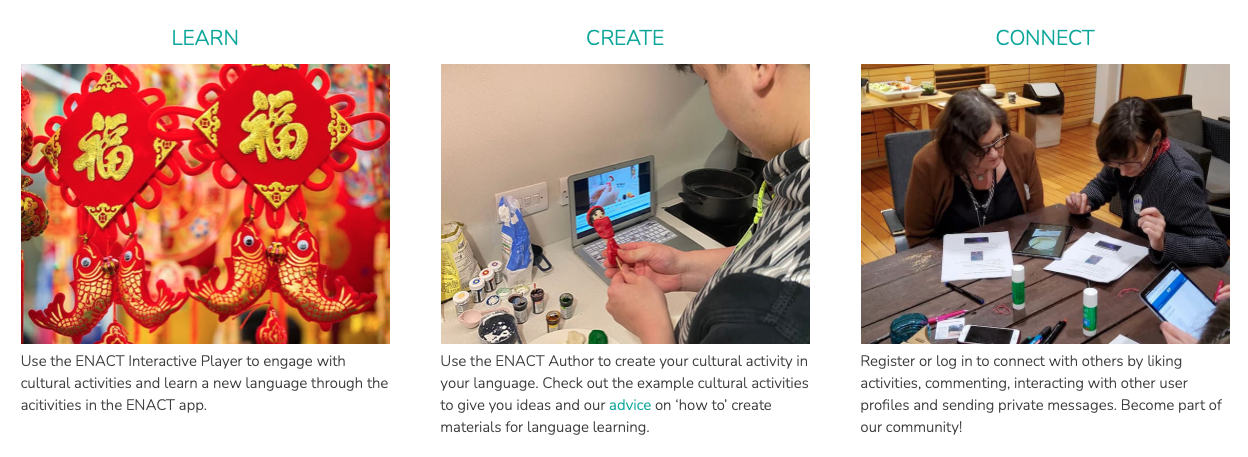
With the ENACT interactive player, people can learn a new language through engaging with cultural activities – our app shows the learner how. Learners can engage with Italian while making a Venetian carnival mask or Turkish while making a shadow puppet. The computer, smartphone, or tablet will guide the learner through the stages of doing the activity through structured interactive content using photos, text, audio, and video to help them. In this way, students can learn something about a country’s language and culture before they visit it, understand more about the languages and cultures of the world, and produce something beautiful. Learning by physically engaging in an activity brings the language and culture to life and helps cross-cultural understanding. The learning experience is more memorable as it involves touch and all four senses. Some activities have interactive 360° videos and images which offer learners an immersive experience.
It’s simple to start learning with ENACT. First, learners will watch a video introducing them to the activity and culture. As they watch the video, they can engage with pop-up questions or additional information. Then, they can study the most important words using interactive images by clicking on the image to see how the word is written and how it is pronounced. Then, a video will show them in detail how they can carry out the activity in pairs or individually as they follow the step-by-step instructions. Some videos have captions and subtitles or pop-up explanations to help them understand the process better. Finally, they can review what they have learnt through simple activities such as drag and drop to review vocabulary, put the process in order, or answer culture related questions.
With the online community, learners can connect with others by liking activities, commenting on what they have learnt about the culture and the language, providing feedback and suggestions, sharing an image and video of others’ cultural activity they re-created, interacting with other user profiles, and sending private messages.
Learners and teachers can also tell others about their own languages and cultures. With ENACT author, maybe you can teach people some English by showing them how to carve a pumpkin for Hallowe’en. If you are worried that you or your learners will not know how to prepare useful learning materials, the web app guides you through a task-based learning structure to prepare your cultural activity, emphasise key vocabulary to learn, and provide appropriate means of assessment. There are also user guides on the ENACT website with advice on activity creation steps and recommendations for creating materials.
We launched the app in February 2021, and currently have cultural activities for English, Catalan, Spanish, Finnish, Russian, Hungarian, Arabic, Persian, Italian, German, Welsh, French, Dendi, Tigrigna, Kazakh, Azerbaijani, Vietnamese, Chinese, Turkish, Korean, and Japanese languages. The fascinating activities include making Karagöz (a Turkish shadow puppet), Chinese lanterns, To He Vietnamese edible toys and Dia de los Muertos makeup from Mexico.
What is the rationale for language learning while doing a cultural activity?
Language and culture have always been closely associated in the field of language learning and teaching. Nowadays, it is almost impossible to think of learning a language without engaging with the culture(s) associated with it. A problem for foreign language teachers around the world has always been how to bring the foreign culture and language to life for learners, as well as the issue of how to motivate people to learn languages. Many learners are motivated to learn languages through their interest in foreign countries and their cultures, and this project taps into this motivation. Our research has shown that (Seedhouse, 2017) people can learn aspects of a foreign language and culture as well as digital skills while carrying out real-world, practical, engaging tasks with a tangible end product.
A significant challenge for nations worldwide is not only how to improve the foreign language proficiency of its workforce and students, but also how to raise intercultural awareness in a globalised world. Interculturality is concerned with how people interact with one another and negotiate cultural and linguistic differences made relevant (or perceived as such) through interaction. The negotiation of interculturality can happen between people from different countries as well as between people who belong to different groups (e.g. linguistic, religious) within the same country. It is important to consider that not all individuals associate ‘languages’ and ‘cultures’ in the same way and that there is no univocal correspondence between languages, culture, and countries.
Of course, the ideal has been for learners to travel to the target country and to learn the cultural practices together with the language in situ. But as we have discovered in times of the COVID-19 pandemic, it is not always possible to travel abroad. Moreover, the expense of travel can in normal times be beyond many learners. We wanted to find out if it is possible to have learners learn a new language while actively and physically engaging in learning themselves in how to carry out some of the proposed cultural activities with the help of interactive media. We have found that it is perfectly possible to do this using the latest digital technology, whilst integrating the principles of Task-Based Language Learning and Teaching (TBLT), which we explain below.
The benefits of physically touching items and using them to produce target vocabulary items in learning lexical items have been demonstrated in our previous studies (Seedhouse, 2017). While doing a cultural activity, learners involve more of their senses, which helps the learning experience and brings the culture to life. The sense of touch is important when making origami and learning Japanese, and the senses of smell and taste are important when making Turkish coffee. By activating all senses at the same time in a meaningful multimodal experience, learners are able to maximise the number of synaptic connections and the likelihood of retaining the new word.
What is the approach to learning?
ENACT is an adaptation of Task-Based Language Learning and Teaching (TBLT), a well-known and well-researched approach to language learning in which learners acquire language while completing a task. Learners work in pairs so they can help each other and also practice speaking to each other in the target language. TBLT has so far predominantly been based on tasks to be undertaken within the classroom which simulate real-world tasks and cultural activities. ENACT can be used in the classroom, but it can also be used at home or in other locations. For some activities like dancing or playground games, learners need some space, and for activities like embroidery or Chinese calligraphy learners need some basic equipment – it all depends on the cultural activity.
So what is the TBLT structure of ENACT tasks? The main task of performing a cultural activity was designed according to Rod Ellis’s (2003) features of language learning tasks in the following ways. The app design encourages learners to focus on meaning rather than purely language – that is, they use the language to complete a cultural activity, rather than focusing primarily on the language itself. Secondly, learners must employ all four language skills in a holistic manner to achieve the task. Thirdly, the task is goal-oriented, involving the production of a cultural activity. Fourthly, tasks are carried out in pairs, which should generate some interaction in the target language (although it is possible to carry out the activities individually, we recommend pair work). Finally, learners can measure their own success in producing the product, i.e. the cultural activity, e.g. an object such as a card or a dance.
In ENACT, the pre-task provides a dual focus on language and culture (Picture 3). First of all, learners watch a video which provides information about the cultural activity. Secondly, they learn key vocabulary necessary for the activity by clicking on photographs which then provide an audio file and the written form of the item. The pre-task prepares the stage for the main task by presenting new language, mobilising existing language knowledge, framing the task, and motivating learners. In the during-task, they carry out the cultural activity by watching a video with step-by-step instructions for them to follow (Picture 4). This phase delivers the main task set, i.e. instructions that users follow to produce the cultural activity. The post-task phase promotes reflection on and analysis of during-task performance, identification of what has been learnt, and as a period of evaluation of the task outcomes or end product. In the post-task, they first do a vocabulary review so they can identify and evaluate their learning, and then reflect and make written notes on the system to evaluate their experience and what they have learnt on both cultural and linguistic levels (Picture 5). They can also share images and videos of their own adaptations of others’ cultural activities. This enables learners to showcase how they make others’ cultural activities their own through first-hand experience. Learners go beyond learning ‘about’ other cultures and actively participate in others’ cultural activities making them something they do rather than something they just know about.
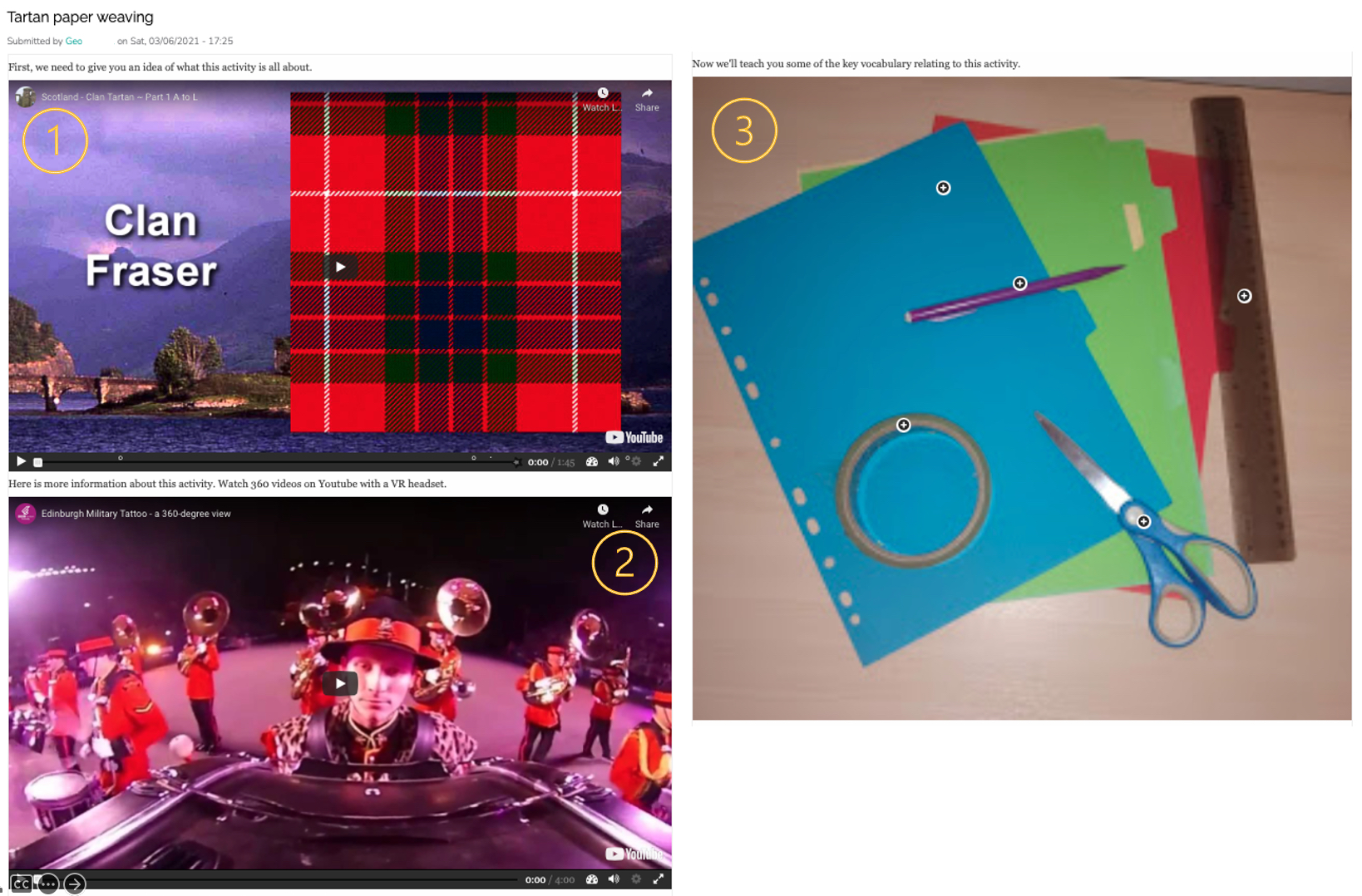

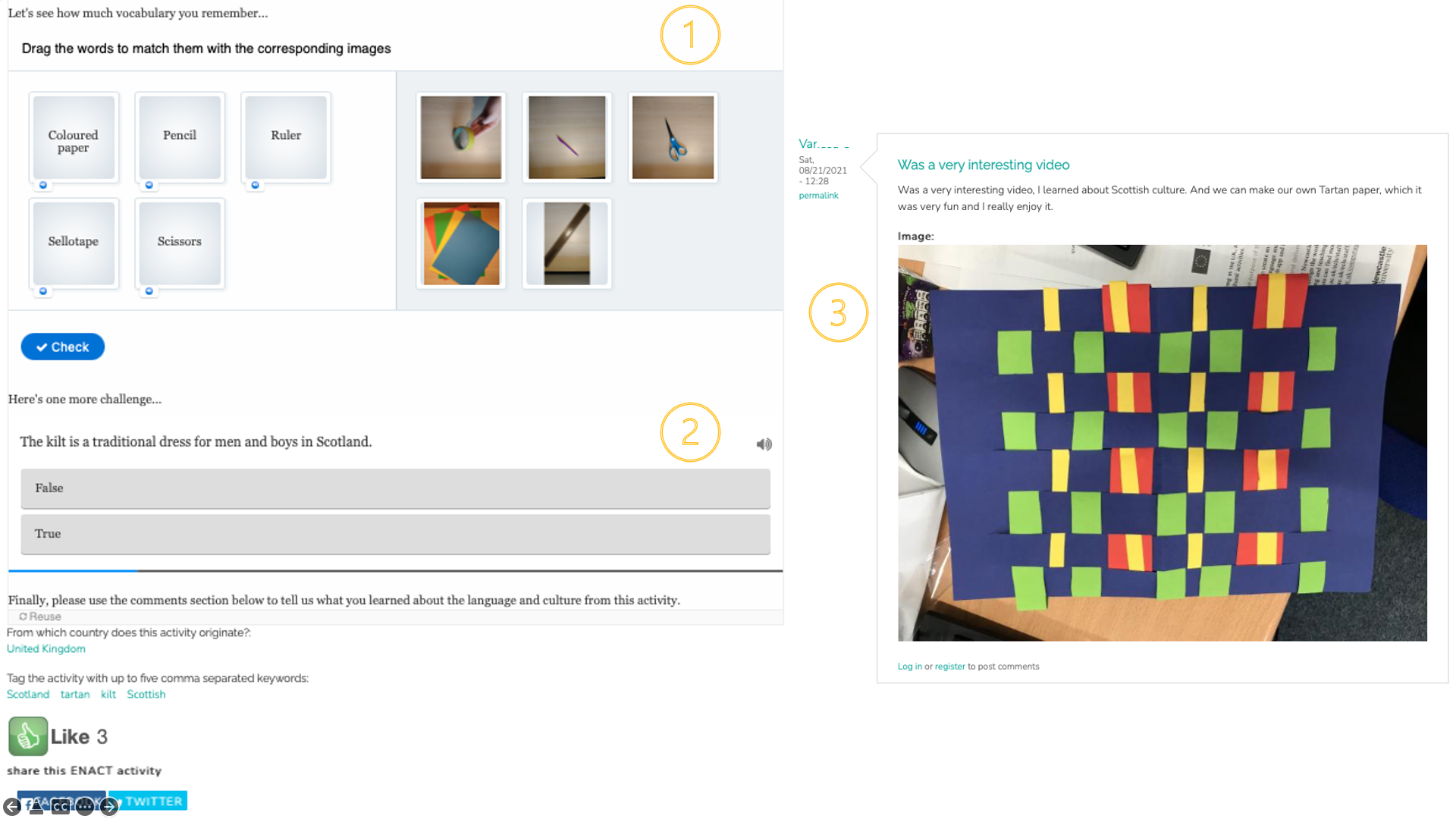
ENACT is built on the H5P engine. While H5P offers individual content types, it does not provide an overall task structure. The ENACT Author addresses this issue by offering a workflow which guides non-expert users (both technologically and pedagogically) in producing digital interactive cultural activities aligned with TBLT. It wraps together selected existing H5P content types within the three-phase TBLT structure and presents instructions for each phase. For example, the pre-task stage starts with the introduction instruction: Select a media type from the menu below and use it to create an introduction giving a sense of the activity’s context. Scaffolding is also automatically provided to the learner when the activity is published. For example, “Now we’ll teach you some of the key vocabulary relating to this activity” this text is used to introduce the vocabulary training content (Dodds, et al., 2021).
How can Teachers and Language Professionals use the ENACT Web App?
ENACT can be used for language lessons, but also for cross-curricular work involving digital skills, geography, culture, and personal and social development. Teachers can use the ENACT web app to mobilise students’ intercultural understanding and increase their awareness of interculturality as part of a wide range of programmes and courses with a focus on languages, cultures, and intercultural communication.
Students can use the app to learn at home as well as at school, so it is ideal for homework or ‘learning in the wild’. The app is a good way of preparing students for a foreign trip as it helps engage them with the cuisines, culture, and language in advance.
A great project for students is for them to work as a team to input their own favourite cultural activities in their own language, using the ENACT author. Project work could also involve students producing their own activities from their own culture to present to a worldwide audience using their own language. To reach a wider audience, the students can easily add captions or subtitles in other languages such as English. This makes for an ideal project involving a wide range of skills. For instance, digital skills can be developed by using the ENACT author software, which was designed to develop a wide range of digital skills using the EU’s DIGCOMP 2.1 framework. We have a digital skills certification system for the project which enables teachers to evaluate learners’ digital skills and provide certification.
The ENACT web app is also an excellent way of getting learners to communicate with learners in other countries. It can be implemented as part of a virtual exchange to facilitate international collaboration between your students and students from another institution in another country. To learn more about how we are implementing the web app for virtual exchange, read our blog post and Dodds et al. (2021) or contact us at enacteuropa@newcastle.ac.uk.
Integration of Migrant Communities
We designed the app in collaboration with a number of migrant communities in the EU, including refugees and asylum seekers. The app is particularly suitable for helping to integrate these groups into EU societies, and for home country members to learn more about the communities in their local area. Migrants can try out the host country’s cultural activities to learn about the language. Secondly, migrants can produce their own cultural activities in their own language using the author tool. People can also work online on building cultural activities with experts from the home country. These are then freely available for use by both community members, thus enabling mutual cultural understanding and two-way integration. ENACT is therefore a useful vehicle for promoting cultural diversity, exchange, and understanding within an inclusive approach. In contrast to the deficit view (in which immigrants are seen as lacking skills and knowledge), the ENACT app provides a space for migrant communities to showcase their cultural heritage, gives them a voice, and empowers them. One of our project workshop participants said:
“It has a direct link with me as an immigrant, telling about yourself, introducing yourself to the others. Before the activity, I was thinking how do I adapt to the community and integrate to the local community. Now after these sessions, I don’t have only to learn the local community’s culture and language but I can also introduce my language and culture to the local community.”
A problem for some migrant communities is that the younger generation does not always learn the language, culture, and activities of the older generation (their cultural heritage), whilst the elders are often lacking in digital skills. The ENACT Web App enables intergenerational exchange of languages and cultural activities by means of digital technology. UNESCO’s definition of cultural heritage “includes traditions or living expressions inherited from our ancestors and passed on to our descendants, such as oral traditions, performing arts, social practices, rituals, festive events, knowledge and practices concerning nature and the universe or the knowledge and skills to produce traditional crafts.” We hope to promote all of these with the ENACT Web App. The author infrastructure has been set up so that any number of new cultural activities can be added in any language, country and culture in the EU and beyond.
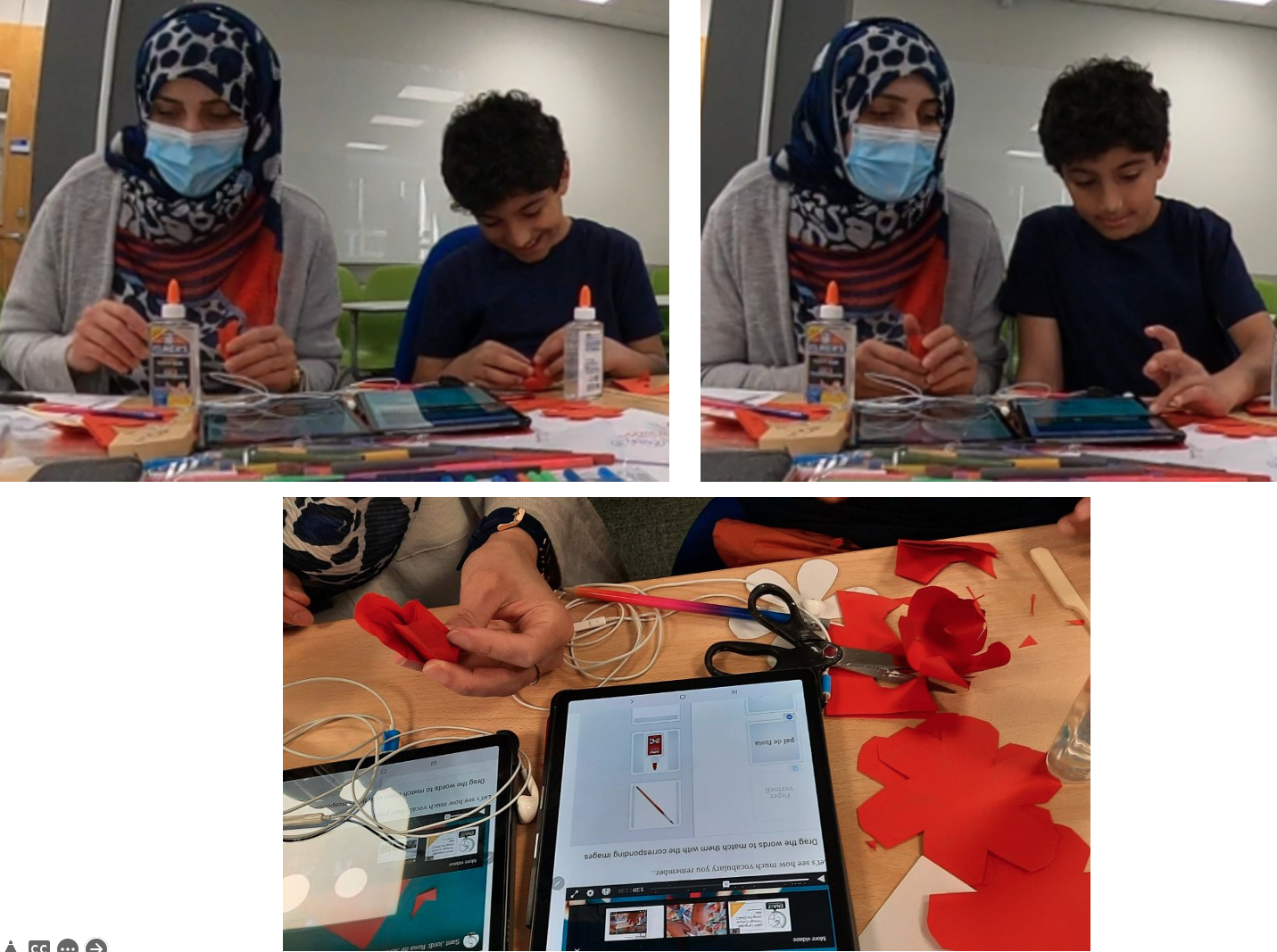
Case Study
One example of an ENACT user from the migrant community is Charden, who came to Newcastle from Congo and has been doing a BA Politics and International Relations degree at Northumbria University. In August 2021, Charden took part in a workshop to learn how to use all features of the ENACT app and carry out a Scottish paper tartan weaving activity. He said:
“Virtual Reality made [the activity] look so real and fun at the same time.”
“I particularly enjoyed weaving the tartans. I guess I feel closer to Scotland now than I ever felt before.”
“I still think that culture is what we do remember when we have forgotten everything else. But I have also learned that culture is so much more than that. It entails various aspects of life such as religion, and social groups.”

Conclusion
The long-term aim of the ENACT Web App is to build up a bank of cultural language learning tasks available for free, covering as many languages, cultures, and countries as possible, and to promote intercultural understanding and communication. The ENACT Web App and website provide a free infrastructure which can be used by all language and culture enthusiasts. We therefore encourage everyone to add their own cultural activity in their own language using the Author tool so that people all over the world can learn from them — and to encourage this, there is an annual ENACT Web App prize for the best cultural language learning activity. Reciprocity is built into the app: any number of new activities can be added in any language, any country and any culture, using the Author tool – no culture has priority. ENACT is therefore a suitable vehicle for promoting inclusive cultural exchange and understanding around the world.
Finally, doing cultural activities for language learning is great fun! ENACT provides a real-world learning experience involving all of the senses in the course of producing something. This cannot be appreciated by simply reading instructions or reviewing the app online, so why not find a workspace, choose an activity in a new language, and see what you learn?
Why not join our online community of people interested in learning and teaching about cultures and languages? Simply go to https://enacteuropa.com/ to try out a cultural activity, create an account to send messages, leave comments, and create your own activity!
Acknowledgements
Communities, Languages, and Activities App (ENACT) project is co-funded by the European Commission, Erasmus Key Action 2 Strategic Partnerships for Higher Education, project number: 2019-1-UK01-KA203-061567. The project is led by Newcastle University, and the other consortium partners are: Boğaziçi University, Cultura Foundation, Universitat Autonoma de Barcelona, and University of Helsinki. In the UK, our associated partners are Action Foundation and North East Solidarity Teaching. The European Commission’s support for the production of the project outputs and publications does not constitute an endorsement of the contents, which reflect the views only of the authors, and the Commission cannot be held responsible for any use which may be made of the information contained therein.
References
Dodds, C. B., Whelan, A., Kharrufa, A., & Satar, M. (2021). Virtual exchange facilitated by interactive, digital, cultural artefacts: communities, languages, and activities app (ENACT). In M. Satar (Ed.), Virtual exchange: towards digital equity in internationalisation (pp. 101-112). Research-publishing.net. https://doi.org/10.14705/rpnet.2021.53.1293
Ellis, R. (2003). Task-based language learning and teaching. Oxford University Press.
Seedhouse, P. (2017). Task-based language learning in a real-world digital environment: The European digital kitchen. Bloomsbury.
Thorne, S. L. (2016). Cultures-of-use and morphologies of communicative action. Language Learning & Technology, 20(2), 185-191.

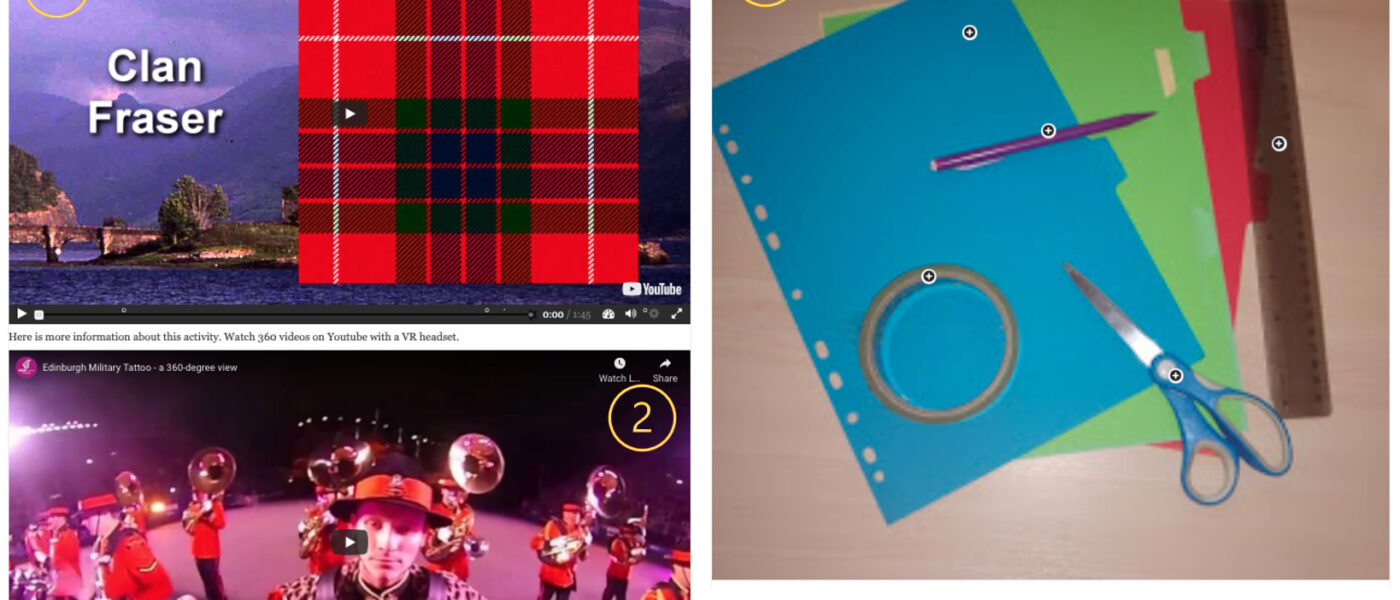
Very informative!
This is so exciting! I see this as something our Language Center can offer to students directly and also to complement our TandemPlus program.